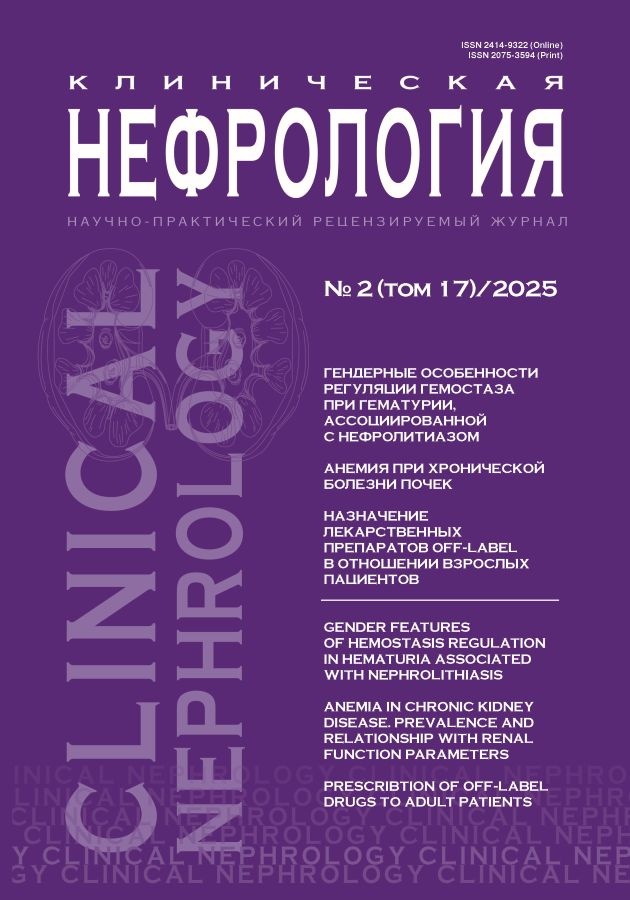Transposition of the vena saphena magna in patients with exhausted vascular access possibilities on the upper limbs
- Авторлар: Yankovoy A.G.1
-
Мекемелер:
- Moscow Regional Research Clinical Institute named after M.F. Vladimirsky
- Шығарылым: Том 17, № 2 (2025)
- Беттер: 55-59
- Бөлім: Clinical case
- URL: https://journals.eco-vector.com/2075-3594/article/view/692770
- DOI: https://doi.org/10.18565/nephrology.2025.2.55-59
- ID: 692770
Дәйексөз келтіру
Аннотация
Vascular access to the forearm in patients undergoing systemic hemodialysis (HD) is one of the key conditions for adequate HD. In situations where it is impossible to create vascular access in the upper limbs and there is total stenosis of the central veins, it is necessary to consider alternative vascular access routes. Formation of femoral arteriovenous fistula (AVF) is one of the possible places for creating such access. The article describes a rather rare type of vascular access, namely, transposition of the vena saphena magna in the form of a linear AVF with anastomosis of the femoral artery in the lower third. The course of the operation is described.
Толық мәтін
Авторлар туралы
Andrey Yankovoy
Moscow Regional Research Clinical Institute named after M.F. Vladimirsky
Хат алмасуға жауапты Автор.
Email: 48yankovoy@mail.ru
Dr.Sci. (Med.), Senior Researcher, Kidney Transplantation Department
Ресей, MoscowӘдебиет тізімі
- NKF, DOQI. Clinical practice guidelines and clinical practice recommendations for 2006 updates: hemodialysis adequacy, peritoneal dialysis adequacy and vascular access. Am. J. Kidney Dis. 2006;48(Suppl. 1):S1e322.
- Kendall T.W., Cull D.L., Carsten C.G. et al. The role of the prosthetic axilloaxillary loop access as a tertiary arteriovenous access procedure. J. Vasc. Surg. 2008;48:389–93. doi: 10.1016/j.jvs.2008.03.030.
- Parekh V.B., Niyyar V.D., Vachharajani T.J. Lower Extremity Permanent Dialysis Vascular Access. Clin. J. Am. Soc. Nephrol. 2016;11:1693. doi: 10.2215/CJN.01780216.
- Antoniou G.A., Lazarides M.K., Georgiadis G.S., et al. Lower-extremity arteriovenous access for haemodialysis: a systematic review. Eur. J. Vasc. Endovasc. Surg. 2009;38:365–72. http://dx.doi.org/10.1016/ j.ejvs.2009.06.003.
- Jackson M.R. The superficial femoral-popliteal vein transposition fistula: description of a new vascular access procedure. J. Am. Coll. Surg. 2000;191:581–4. doi: 10.1016/s1072-7515(00)00707-9.
- Huber T.S., Ozaki C.K., Flynn T.C., et al. Use of superficial femoral vein for hemodialysis arteriovenous access. J. Vasc. Surg. 2000;31:1038–41. doi: 10.1067/mva.2000.104587.
- Gradman W.S., Cohen W., Haji-Aghaii M. Arteriovenous fistula construction in the thigh with transposed superficial femoral vein: our initial experience. J. Vasc. Surg. 2001;33:968–75. http://dx.doi.org/10.1067/mva.2001.115000.
- Bourquelot P., Rawa M., Van Laere O., Franco G. Long-term results of femoral vein transposition for autogenous arteriovenous hemodialysis access. J. Vasc. Surg. 2012;56:440–5. doi: 10.1016/j.jvs.2012.01.068.
- Miller C.D., Robbin M.L., Barker J., Allon M. Comparison of arteriovenous grafts in the thigh and upper extremities in hemodialysis patients. J. Am. Soc. Nephrol 2003;14:2942–7. doi: 10.1097/01.asn.0000090746.88608.94.
- Ram S.J., Sachdeva B.A., Bharat A., et al. Thigh grafts contribute significantly to patients’ time on dialysis. Clin. J. Am. Soc. Nephrol. 2010;5:1229–34. doi: 10.2215/CJN.08561109.
- Aitken E., Jackson A.J., Kasthuri R., et al. Bilateral central vein stenosis: options for dialysis access and renal replacement therapy when all upper extremity access possibilities have been lost. J. Vasc. Access. 2014;15:466–73. doi: 10.5301/jva.5000268.
- Hazinedaroglu S.M., Tuzuner A., Ayli D., et al. Femoral vein transposition versus femoral loop grafts for hemodialysis: a prospective evaluation. Transplant. Proc. 2004;36:65–7. doi: 10.1016/j.transproceed.2003.11.031.
- Murad M.H., Elamin M.B., Sidawy A.N., et al. Autogenous versus prosthetic vascular access for hemodialysis: a systematic review and meta-analysis. J. Vasc. Surg. 2008;48(Suppl. 5): S34–47. doi: 10.1016/j.jvs.2008.08.044.
- Huber T.S., Carter J.W., Carter R.L., Seeger J.M. Patency of autogenous and polytetrafluoroethylene upper extremity arteriovenous hemodialysis accesses: a systematic review. J. Vasc. Surg. 2003;38(5):1005e11. Doi: 10.1016/ s0741-5214(03)00426-9.
- Georgakarakos E., Georgiadis G.S., Schoretsanitis N.G., et al. Composite PTFE-transposed superficial femoral vein for lower limb arteriovenous access. J. Vasc. Access. 2011;12:253–7. doi: 10.5301/JVA.2011.6387.
- Farber A., Woo K. Transposed arteriovenous fistulae: do the results justify the effort? Semin. Vasc. Surg. 2007;20:148–57. Doi: 10.1053/ j.semvascsurg.2007.07.008
- White J.G., Kim A., Josephs L.G., Menzoian J.O. The hemodynamics of steal syndrome and its treatment. Ann. Vasc. Surg. 1999;13:308–12. doi: 10.1007/s100169900263.
- Georgakarakos E.I., Georgiadis G.S., et al. Composite PTFE-transposed superficial femoral vein for lower limb arteriovenous access. Vasc. Access. 2011;12(3):253–7. doi: 10.5301/JVA.2011.6387.
- Korzets A., Ori Y., Baytner S., et al. The femoral artery-femoral vein polytetrafluoroethylene graft: a 14-year retrospective study. Nephrol. Dial. Transplant. 1998;13(5):1215e20. doi: 10.1093/ndt/13.5.1215.
- Miller C.D., Robbin M.L., Barker J., Allon M. Comparison of arteriovenous grafts in the thigh and upper extremities in hemodialysis patients. J. Am. Soc. Nephrol. 2003;14(11):2942e7. doi: 10.1097/01.asn.0000090746.88608.94.
- Khadra M.H., Dwyer A.J., Thompson J.F. Advantages of polytetrafluoroethylene arteriovenous loops in the thigh for hemodialysis access. Am. J. Surg. 1997;173(4):280e3. doi: 10.1016/S0002-9610(96)00405-9.
Қосымша файлдар













